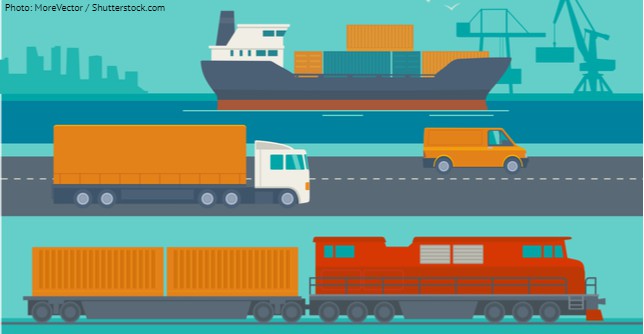According to data released Tuesday by the Bureau of Transportation Statistics, the total value of U.S.-North American freight flows increased 7.8 percent to $1.23 trillion.
The value of North American transborder freight increased in five modes of transportation — truck, rail, vessel, pipeline and air — in 2018, according to data released Tuesday by the Bureau of Transportation Statistics.
The five modes combined for a total value of $1.17 trillion in 2018, which was an 8.3 percent increase over the $1.08 trillion combined value from 2017. The value of U.S.-North American freight flows across all modes, which also includes shipment made by mail, foreign trade zones and other transportation, grew 7.8 percent to $1.23 trillion.
Truck freight accounted for 62.8 percent of all transborder freight in 2018 as it moved $772.24 billion of freight, which was up 7.1 percent over 2017. The mode, which made up 69.3 percent of all southern border freight, increased its U.S.-Mexico freight 10.2 percent to $424 billion. The U.S.-Canada freight totaled $348.28 billion, which was a 3.6 percent increase and 56.4 percent of all northern border freight.
Laredo, Texas ($184.3 billion), Detroit ($109.2 billion) and El Paso, Texas ($63.08 billion) were the three busiest U.S. truck border ports and handled 46.2 percent of the total transborder truck freight. More than half of the total truck commodities were made up of computers and parts ($151.2 billion), electrical machinery ($123.76 billion) and motor vehicles and parts ($119.74 billion).
Rail was the second most-used mode, moving $178.84 billion in freight in 2018, which was a 2.7 percent increase over 2017. Rail freight grew 6.7 percent at the northern border to $100.47 billion, which accounted for 16.3 percent of all U.S.-Canada freight. The mode’s U.S.-Mexico freight dropped 2 percent to $78.37 billion, which was still good for 12.8 percent of all southern border freight.
The three busiest U.S. rail border ports, which handled 52.4 percent of total transborder rail freight, were Laredo ($43.33 billion), Port Huron, Mich. ($25.71 billion) and Detroit ($24.67 billion). The top three rail commodities, which accounted for 60 percent of transborder rail freight, were motor vehicles and parts ($83.45 billion), mineral fuels ($13 billion) and plastics ($11 billion).
Vessel was the third-most used mode at $96.54 billion in freight moved, but its 27.6 percent increase was more than double the next closest increase. U.S.-Canada vessel freight flow grew 29.9 percent to $29.72 billion, including a 75.5 percent jump in exports to $13.74 billion. Vessel freight flow between U.S. and Mexico increased 26.6 percent to $66.81 billion.

Houston ($19.25 billion), New Orleans Customs District ($12.6 billion) and Port Arthur, Texas, Customs District ($10.1 billion) were the top three U.S. vessel ports. Mineral fuels ($62.5 billion) were the top vessel commodity, followed by motor vehicles ($12.78 billion) and organic chemicals ($5.1 billion).
“Of freight by vessel between the U.S. and Mexico, $38 billion, or 57.5 percent, were mineral fuels, primarily oil and gas shipments between Gulf of Mexico ports in the U.S. and Mexico — with over half of those shipments going through Texas ports,” BTS said in the statistics.
Pipeline freight flow increased 12.6 percent to $73.5 billion. Freight flow at the northern border increased 10.8 percent to $68.3 billion, while the southern border grew by 43.2 percent to $5.2 billion. The jump in the U.S.-Mexico freight flow was aided by a 45.4 increase in exports to $5.05 billion.
“Almost all (99.4 percent) of pipeline freight between the U.S. and Canada were mineral fuels, primarily oil and gas,” the bureau said. “Most of these freight flows were on pipelines linking Canada and the American Midwest.”
Mineral fuels accounted for $73.11 billion, followed by organic chemicals ($256 million) and pulp of wood and paperboard ($106 million) among pipeline commodities. The Chicago Customs District was the busiest U.S. pipeline port with $25 billion. Port Huron handled $7.1 billion and Minneapolis-St. Paul handled $5 billion.
Air freight grew by 6.9 percent to $46.83 billion in 2018. Air freight flow between U.S. and Canada increased 9.5 percent to $29.6 billion and between U.S. and Mexico grew 2.5 percent to $17.07 billion.
New Orleans Customs District was the busiest U.S. port for air freight, handling $15.71 billion. It was followed by Cleveland, Ohio ($8 billion) and Cleveland Customs District ($2.9 billion). Electrical machinery ($11.03 billion), computer-related machinery and parts ($8.11 billion) and pearls, stones, metals and imitation jewelry ($6.68 billion) were the top three air freight commodities.










